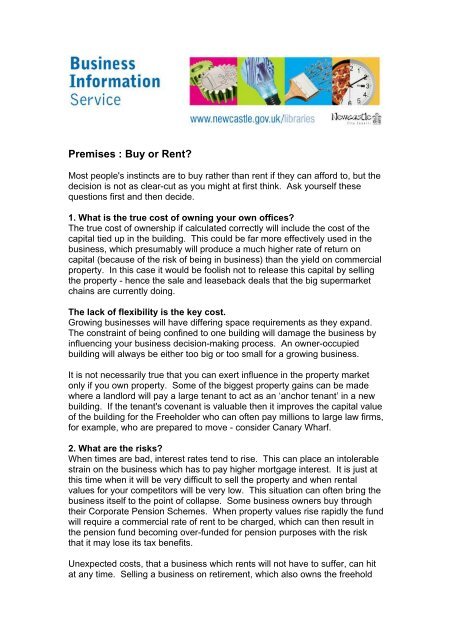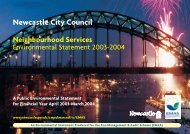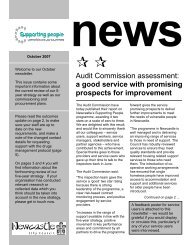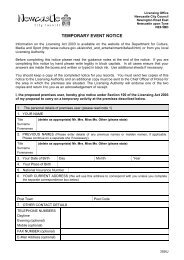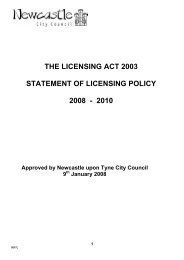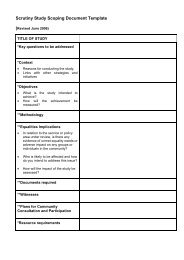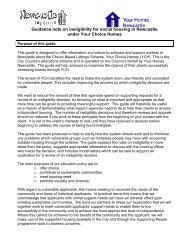Premises : Buy or Rent?
Premises : Buy or Rent?
Premises : Buy or Rent?
Create successful ePaper yourself
Turn your PDF publications into a flip-book with our unique Google optimized e-Paper software.
<strong>Premises</strong> : <strong>Buy</strong> <strong>or</strong> <strong>Rent</strong>?Most people's instincts are to buy rather than rent if they can aff<strong>or</strong>d to, but thedecision is not as clear-cut as you might at first think. Ask yourself thesequestions first and then decide.1. What is the true cost of owning your own offices?The true cost of ownership if calculated c<strong>or</strong>rectly will include the cost of thecapital tied up in the building. This could be far m<strong>or</strong>e effectively used in thebusiness, which presumably will produce a much higher rate of return oncapital (because of the risk of being in business) than the yield on commercialproperty. In this case it would be foolish not to release this capital by sellingthe property - hence the sale and leaseback deals that the big supermarketchains are currently doing.The lack of flexibility is the key cost.Growing businesses will have differing space requirements as they expand.The constraint of being confined to one building will damage the business byinfluencing your business decision-making process. An owner-occupiedbuilding will always be either too big <strong>or</strong> too small f<strong>or</strong> a growing business.It is not necessarily true that you can exert influence in the property marketonly if you own property. Some of the biggest property gains can be madewhere a landl<strong>or</strong>d will pay a large tenant to act as an ‘anch<strong>or</strong> tenant’ in a newbuilding. If the tenant's covenant is valuable then it improves the capital valueof the building f<strong>or</strong> the Freeholder who can often pay millions to large law firms,f<strong>or</strong> example, who are prepared to move - consider Canary Wharf.2. What are the risks?When times are bad, interest rates tend to rise. This can place an intolerablestrain on the business which has to pay higher m<strong>or</strong>tgage interest. It is just atthis time when it will be very difficult to sell the property and when rentalvalues f<strong>or</strong> your competit<strong>or</strong>s will be very low. This situation can often bring thebusiness itself to the point of collapse. Some business owners buy throughtheir C<strong>or</strong>p<strong>or</strong>ate Pension Schemes. When property values rise rapidly the fundwill require a commercial rate of rent to be charged, which can then result inthe pension fund becoming over-funded f<strong>or</strong> pension purposes with the riskthat it may lose its tax benefits.Unexpected costs, that a business which rents will not have to suffer, can hitat any time. Selling a business on retirement, which also owns the freehold
in the early stages. Take on premises that are too small and you may findthat your expansion is constrained by lack of space in the existing buildingand very heavy costs if you try to move somewhere else.A business looking f<strong>or</strong> new premises, whether it is a start-up <strong>or</strong> a matureconcern, has a number of decisions to make right at the outset.First, it must choose between buying a building <strong>or</strong> finding premises that it willoccupy as a tenant.Second, if you decide to follow the renting rather than the purchasing route,you face a further serious decision. F<strong>or</strong> how long do you want to commityourself? Taking a lease of premises is a serious business. A lease is abinding contract in law. Take a lease f<strong>or</strong> ten years and you cannot simplywalk away from it after three years if your premises prove unsuitable <strong>or</strong> yourbusiness fails to develop as you expected. It may prove very expensive toextricate yourself from your commitment in terms of time as well as money.There could be better solutions.The usual advice to an established business looking f<strong>or</strong> new premises is to tryto visualise the business in five years’ time. How do you expect it to havedeveloped? What do you expect its space needs to be at that point? Then tryto find a building that meets (<strong>or</strong> can be extended to meet) your requirementsat least that far ahead. A new enterprise should be asking itself the samequestions. But it is not always so easy to come up with the answers. Whileselecting the right premises will always be a trade-off between security andflexibility, the new business should err on the side of flexibility. Considersome of the pros and cons of the different property options:<strong>Buy</strong>ing your premisesSome cash up-front will probably be required even if you can cover most ofthe cost with a m<strong>or</strong>tgage. Gives you security and perhaps an asset that willincrease in value. Not very flexible in one sense. If you need to move you willhave the cost and administrative problems of finding a buyer and arranging asale. On the other hand, you would have m<strong>or</strong>e flexibility, extending thebuilding later if the site allows it. You will also be able to alter the building inother ways without needing a landl<strong>or</strong>d’s permission. Businesses that will beinstalling processing plant with a long lifespan may need the security aff<strong>or</strong>dedby ownership of the building (<strong>or</strong> at least by a very long lease).Leasing your premisesLeases come in all shapes and sizes, whether you negotiate a new one withthe landl<strong>or</strong>d <strong>or</strong> take an assignment of an existing lease. N<strong>or</strong>mally, a businesstenant will have security of tenure under the Landl<strong>or</strong>d and Tenant Act 1954,and may require the landl<strong>or</strong>d to grant a new lease when the existing oneexpires. But not always. A relatively sh<strong>or</strong>t (say five-year) lease does notmean the tenant necessarily has to leave at the end of this term and theref<strong>or</strong>eoffers flexibility. A long lease (say 25 years) is a long-term commitment. Ifyour space needs change bef<strong>or</strong>e the term is up you will have to arrange toassign the lease <strong>or</strong> to sub-let the building and you probably retain some ongoingresponsibilities. With the help of your chartered survey<strong>or</strong> and solicit<strong>or</strong>you need to examine all the terms of any lease extremely carefully bef<strong>or</strong>e
signing. Especially imp<strong>or</strong>tant are the question of security of tenure and theclauses relating to rent reviews, assignment, sub-letting, repair obligationsand service charges.Occupying a building under licenceA licence is n<strong>or</strong>mally a sh<strong>or</strong>ter-term arrangement than a lease, is notgoverned by landl<strong>or</strong>d and tenant legislation and does not offer security oftenure. It may be possible to occupy premises under a licence by the month<strong>or</strong> even by the week. This often suits start-up businesses. They can limittheir financial commitment in case their business plans do not w<strong>or</strong>k out.Seasonal shops are often made available under licence. Starter offices aresometimes provided under licence by regional development agencies and oldmulti-st<strong>or</strong>ey warehouses may be renovated to provide small office suites <strong>or</strong>even individual rooms. Old industrial buildings may be divided up to house anumber of individual manufacturing businesses, occupying the space underlicence. And owners <strong>or</strong> tenants of virtually any type of building may find itconvenient to offer space that is surplus to their own requirements under alicence arrangement.Whichever option you choose, make sure you really understand what you aregetting into bef<strong>or</strong>e you commit yourself. Getting out can prove a lot m<strong>or</strong>eexpensive than getting in.


